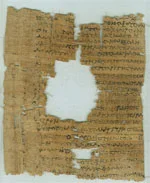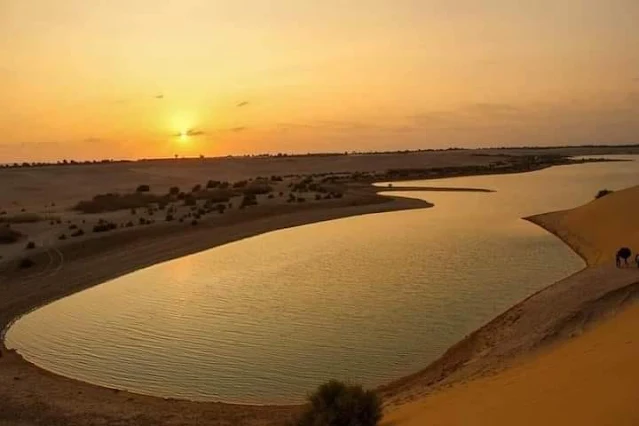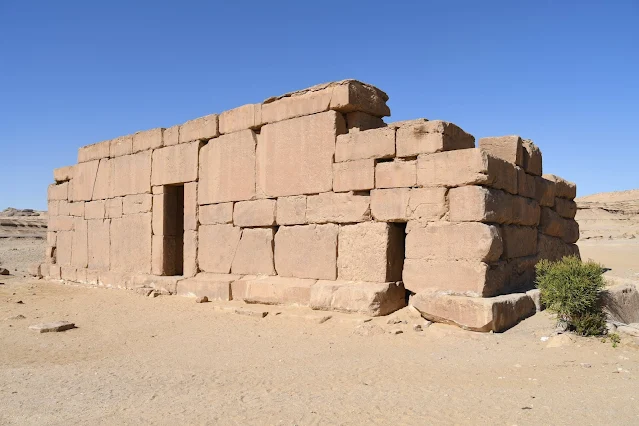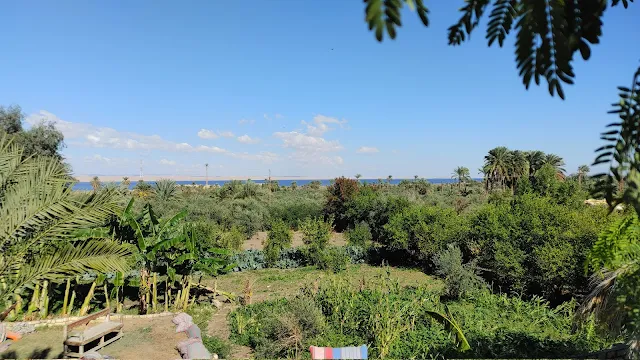
Explore Fayoum .. Where History Meets Nature
7 April 2023
Hawara pyramid in Fayoum photo collection

1 March 2023
Labyrinth of Egypt | Amenemhet III the greatest king in Fayoum
Labyrinth of Egypt | Amenemhet III (king of Egypt) the greatest king in Fayoum Labyrinth of Egypt
Amenemhat III, also spelled Amenemhet III, was a pharaoh of the Twelfth Dynasty of Egypt. He ruled from c.1860 BC to c.1814 BC, the highest known date being found in a papyrus dated to Regnal Year 46, I Akhet 22 of his rule. His reign is regarded as the golden age of the Middle Kingdom. He may have had a long coregency (of 20 years) with his father, Senusret III.
Amenemhet III (king of Egypt) the greatest king in Fayoum Labyrinth of Egypt
NEFERUPTAH AND HER MYSTERIOUS PYRAMID
The field work on the tomb was shared by Dr. Zaky Iskander, the Director of the Chemical Laboratory, and Farag himself. The result of their work confirmed Farag’s expectation. The limestone blocks proved to cover an intact burial chamber of what is thought to be Pyramid of Princess Neferuptah of the Twelfth Dynasty.
This pyramid is situated about two kilometres to the south east of the Hawara Pyramid of her father Amenemhet III, about 13 kilometres to the south east of the Fayûm city. the pyramid lies at the present time about 20 metres to the west of the Bahr Wahbi Canal. As found now, the ruins of the pyramid form a mound of dark grey mud bricks. This pyramid constituted the superstructure of the tomb. It was composed mainly of mud bricks which were most probably overlaid originally with a casing of limestone blocks. No remains of the casing stones, however, could be found. It seems that the site was used as a quarry in ancient times, and the casing stones were ravaged for stone and lime.

In the center of the area of the base of the pyramid, lies the burial chamber .This was made in the following way : A large rectangular shaft was sunk into the bed-rock of the desert. This shaft was lined with small limestone blocks and covered with seven huge blocks of limestone forming the roof of the chamber.
William Flinders Petrie excavated at Hawara in 1888. After working in Medinet el-Fayum (Arsinoe) and Biahmu, he moved on to the site south of Arsinoe and took the 60 workers he had already employed at the former sites with him. The results of his excavations at Hawara were published in 1889 in his "Hawara, Biahmu, and Arsinoe". The papyrological material said to have been found at Hawara was studied by Prof. Sayce and published on pages 24 to 37 of that volume. Sayce gave a general description of the great papyrus roll which contains parts of books 1 and 2 of the Iliad (the "Hawara Homer"), emphasizing the importance of the variants, and edited the texts of the most complete documents, some of them in a very preliminary way.
J. G. Milne undertook a new edition of 37 of these papyri in the Archiv für Papyrusforschung 5, 1913, 378-397. He did not work on the Hawara Homer but concentrated on the smaller literary texts and gave a proper publication of some more documents. The texts which were not reconsidered in Milne's publication were reprinted in Sammelbuch I (nos. 5220, 5223, 5224).
When Flinders Petrie brought his finds back to England, the material was divided between several institutions. The Hawara Homer was given to the Bodleian Library in Oxford (where it still is today), while all the other papyrological material stayed in London and was given to the Department of Egyptology at University College London. In 1948, the young professor of Papyrology, Eric Turner received permission from the then Professor of Egyptology, J. Czerny, to take the Hawara papyri to the Department of Greek and Latin at UCL and to keep them there in his custody. A letter from 16 June 1949 confirms the transfer of the papyri. They were kept in a secret place in the department for more than 50 years.
As usual, Flinders Petrie did not give precise indications, as to where the papyri were found on the site. He just mentions that the region north of the pyramid "was the usual place for burials in the early Roman period , when gilt cartonnage busts were used. Papyri from the Ist and IInd cent. AD are also usual in the soil here, and for some way north" (p. 8, no. 11; cf. the map on plate XXV in the book). When the papyri arrived in London they were "ironed" by Petrie's friend, Mr. Spurrell who also helped in "unpacking, arranging, and managing the collections" (p. 4). It must have happened then that all the pieces were glued onto greyish cardboard. When writing was distiguishable on the back of the papyri, windows were cut out to make the letters (at least in part) visible. In some instances, Petrie added small notes in pencil about find-spots. In later years, Walter Cockle removed some of the papyri from their cardboards and put them under glass. The cardboard frames of these pieces were nevertheless kept.
Amenemhat III
Neferuptah Jewellery
14 January 2023
Top Attractions in Fayoum
Fayoum is an oasis in Egypt located about 85 miles southwest of Cairo. It is known for its many natural attractions, including Lake Qarun and the Wadi El-Rayan Protected Area. The area is also home to several ancient monuments, including the ruins of Karanis.
Fayoum Oasis is an oasis in Egypt located approximately 85km southwest of Cairo. It is the largest oasis in the country, covering an area of about 2,800 square kilometers. The oasis is home to a variety of wildlife and vegetation, including palm trees, papyrus plants, and numerous bird species. It also contains several important archaeological sites from ancient Egypt.
Hawara pyramid
The Hawara pyramid is an ancient Egyptian burial complex located in the Fayoum oasis. It was built by Pharaoh Amenemhat III of the 12th dynasty, and is one of the most intact pyramids in Egypt. The Hawara pyramid includes a large court, a temple, and several underground chambers. The entrance to the pyramid is a long, sloping corridor, which leads to a burial chamber containing several mummies. The pyramid also features a complex system of shafts and tunnels, which were used to hide the burial chamber from looters. The complex is surrounded by a mud-brick wall, and is one of the best-preserved pyramids in Egypt.
Lahun Pyramid
The Lahun Pyramid is an ancient Egyptian pyramid located in the Fayoum oasis. It was built by Pharaoh Senusret II of the 12th dynasty and is one of the best-preserved pyramids in Egypt. The pyramid includes a large court, a temple, and several. underground chambers. The entrance to the pyramid is a long, sloping corridor, which leads to a burial chamber containing several mummies. The pyramid also features a complex system of shafts and tunnels, which were used to hide the burial chamber from looters. The complex is surrounded by a mud-brick wall, and is one of the best-preserved pyramids in Egypt.
What is kahun?
Kahun is an ancient Egyptian town located in the Fayoum oasis. It was built by Pharaoh Senusret II of the 12th dynasty and is one of the best-preserved towns in Egypt. The town includes a large court, several temples, and several residential areas. The most notable structure in Kahun is the pyramid of Senusret II, which stands at approximately 60 feet 48 meters) tall. The town also features a complex system of shafts and tunnels, which were used to hide important structures from looters.
Wadi Hitan
Wadi Hitan is a protected area in the Fayoum oasis of Egypt. It is home to some of the world’s best-preserved fossils of ancient whales, sharks, and other marine animals. The area also features numerous natural attractions such as hot springs, sand dunes, and salt lakes. Wadi Hitan was designated as a UNESCO World Heritage Site in 2005 due to its unique geological features and its importance for scientific research.
Dimeh el Sebaa
Dimeh el Sebaa (Soknopaiu Nesos) is an ancient Egyptian archaeological site located in the Fayoum oasis of Egypt. It was first discovered in 1894 by British archaeologist Flinders Petrie and is one of the best-preserved sites from the Middle Kingdom period. The site includes numerous monuments, including a temple dedicated to Sobek, a crocodile god. The site also features several tombs and stelae, which provide valuable insight into ancient Egyptian culture and religion. Dimeh el Sebaa (Soknopaiu Nesos) was designated as a UNESCO World Heritage Site in 1979 due to its importance for scientific research.
Camping in Fayoum
Camping in Fayoum is a great way to experience the natural beauty of the oasis. There are several camping sites located around Lake Qarun, Wadi El-Rayan Protected Area, and other natural attractions in Fayoum. Campers can enjoy activities such as swimming, bird watching, and exploring the ruins of ancient monuments. Most campsites offer basic amenities such as restrooms and showers, but campers should be prepared for hot weather and bring plenty of water.
Tunis village in Fayoum
Tunis Village is a small village located in the Fayoum oasis of Egypt. It is home to approximately 2,000 people and is known for its unique culture and architecture. The village includes several mosques, a traditional market, and numerous mud-brick houses. Tunis Village also features a number of ancient monuments, including the ruins of an old fort and several tombs from the Middle Kingdom period. Visitors to Tunis Village can explore the local culture, enjoy traditional cuisine, and take part in activities such as camel riding and sandboarding.
Fayoum Attractions
Featured post
Fayoum Grand Tour .. Discover Secrets of Fayoum
Fayoum Grand Tour .. Discover Secrets of Fayoum To visit Fayoum one day not enough so Fayoum Grand Tour covers important places in Fayoum ...




















